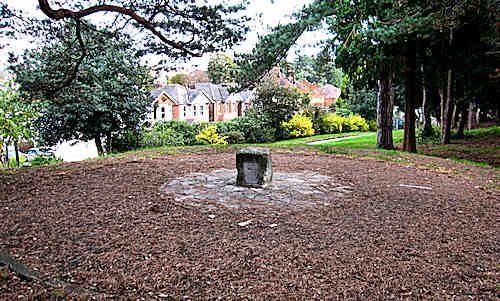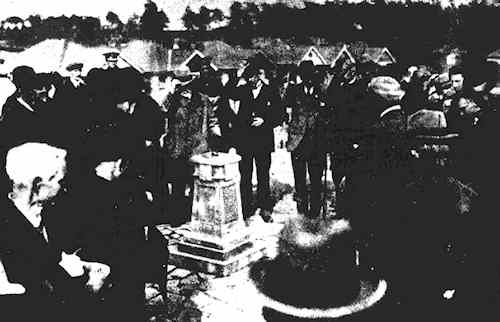|
The Fampoux Gardens
The story of one of Bournemouth's least well known,
yet most touching memorials to the dead of the First World War.
It was built by the survivors in memory of their fallen comrades.
Origins
 The
eastern end of Green Road was laid out around 1910, by 1922 proposals
were being made for it to be adopted as part of the public highway,
which happened on 23rd February. As part of the scheme to complete
the development of this area of town, a small Pleasure Gardens,
of one-and-a-half acres, was to be formed on the site of the former
claypit and brickfield in Green Road. The
eastern end of Green Road was laid out around 1910, by 1922 proposals
were being made for it to be adopted as part of the public highway,
which happened on 23rd February. As part of the scheme to complete
the development of this area of town, a small Pleasure Gardens,
of one-and-a-half acres, was to be formed on the site of the former
claypit and brickfield in Green Road.
Deeply excavated sites such as this were difficult
to adapt for house plots, and it was simpler to landscape them
and create a park. Additionally the question of land ownership
arose. The pleasure grounds were formed from allotment 30, which
had been set aside as a claypit, rather than being sold off for
private use. Using the land for a public garden avoided the difficult
issue of extinguishing any historic public rights to the land.
On 8th March 1922 the Parks committee heard a proposal
from the British Legion in relation to the Green Road Pleasure
Grounds. Following an Armistice Day collection, £460 was
delivered to the British Legion; of this the Legion wished to
pay £400 to Bournemouth Council to secure work for unemployed
ex-servicemen.
As a result of a meeting between the Legion, the
Borough Engineer and the Parks Superintendent, it was decided
that the ex-servicemen could be put to work on the pleasure gardens
in Green Road.
Ex-servicemen
In laying out the gardens, the Council would supply
the tools and materials and the British Legion would provide the
labour.
Married men with families were selected for the
work, in order that the wages would benefit as many people as
possible. One of the first tasks would be to build a concrete
wall along the Green Road frontage.
By 11th June Mr H. T. Symons, the honorary Secretary
of the British Legion was writing to the council to say that the
original fund of £400 had been exhausted, and the gardens
were not yet complete. The Rotary Club came to the rescue on 13th
June, with an offer of a gift of £200 and on 15th June the
Parks Superintendent was ordered to see the work on the gardens
completed.
Fampoux Gardens get their name
The gardens were completed and known for several
months as the Green Road Pleasure Gardens until, on 11th March
1923, Major General Sir Harry Triscott Brooking, KCB, KCSI, KCMG
wrote to suggest that the gardens should be named 'Fampoux' in
view of the part played by the Hampshire Regiment at the Battle
of Fampoux on 28th March 1918.
He also suggested that a board should be put up
in the gardens to record the part played at Fampoux by the regiment
and that the gardens should have a formal opening.

Opening Cermony - 21 April, 1923 |
On 15th March the Parks and Pleasure Grounds Committee
resolved that the name would be changed to Fampoux Pleasure Ground
and that a sundial would be erected bearing an inscription that
would 'record the work of the Hampshires'. The chairman of the
committee was authorised to arrange a formal opening.
The notion of using public spaces to mark the horrifying
events of the 'Great War' was gathering momentum at this time.
Just under a month later, on 12th April, the committee approved
plans submitted by Mr Shervey for a War Memorial in the Central
Gardens close to Bournemouth Town Hall.
Formal Opening
On 21st April 1923, the Parks and Pleasure Grounds
Visiting Committee (comprising Alderman Nethercoate - the chairman,
Alderman Mate, Alderman Elcock, Charles Fox, Councillor Chamberlain,
Councillor John Fox, Councillor Harris, Councillor Pratten, Councillor
Sparkes, Councillor Thwaites, and the Mayor, Alderman Cartwright)
visited Fampoux Gardens for the opening ceremony.
Sir Harry Brooking, of the British Legion, explained
the part that members of the British Legion had played in setting
out the gardens. Sir Harry handed the grounds over to the Mayor,
who then formally opened the gardens; he congratulated the British
Legion for the scheme of bringing employment to ex-service men,
which 'avoided the pernicious system of doles'.
Then Alderman Nethercoate, the chairman of the committee,
formally accepted the ongoing care of the gardens.
A sundial had been placed on a circular spot at
the highest part of the gardens, and on the side was the following
inscription:
'On March 28th, 1918 the enemy launched a big attack
at Fampoux. The Hampshires refusing to be driven back, the enemy
received a serious defeat'.
Background to the Fampoux sacrifice

Contemporary artist's impression
of the battle |
The village of Fampoux in Northern France was taken
from the Germans during the Battle of Arras in 1917. It remained
behind the Allied front line until the Germans' final Spring Offensive
a year later.
The Germans were desperate to secure a victory and
on 28th March 1918 made a heavy attack on the British and French
lines.
Fampoux was at the centre point of the assault,
and its control was vital to both sides. After heavy shelling
and fierce fighting, German infantry captured part of the village
- but the British, including many men of the Hampshire Regiment,
though tremendously hard-pressed, maintained their hold on the
remainder.
It was this stand at the Battle of Fampoux that
is commemorated by the Fampoux gardens.
The dreadful toll on human life is born witness
by the fact that there are no less than five war cemeteries around
the village of Fampoux. They contain the graves of many hundreds
of soldiers - some of whom will never be identified.
They are however remembered by the Fampoux Gardens
in Winton.
Click here to read
more about Winton during the "Great War".
|